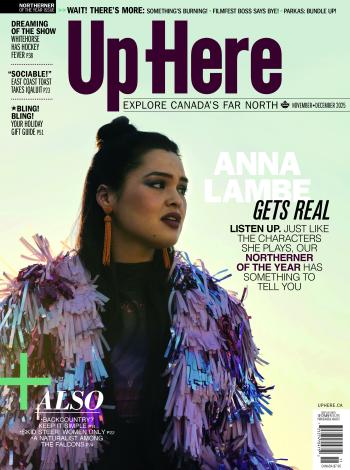Tarralik Duffy and I are discussing the various merits of soy sauce. “I can’t escape the idea that China Lily is running through my veins,” she says. “It’s the best.”
A multimedia Inuk artist from Salliq, Nunavut, Duffy is known for her drawings, prints, and soft sculptures of pantry items and everyday objects – Klik, pop, jerry cans – that are staples of contemporary Inuit culture. She’s drawn Bick’s mustard pickles, frequently enjoyed with stewed seal. Heinz 57 sauce is an excellent match with boiled maataq. And China Lily? It’s great with frozen Arctic char.
Duffy often depicts her grocery items in a repeating grid pattern, “the placement of can by can by can,” in homage to the uniformity of store shelves. Her related work is lighthearted and humorous, connecting with Inuit audiences across the country. “My favourite flavoured water,” reads a tongue-in-cheek comment on Duffy’s Instagram post of her cans of Maple Leaf Vienna Sausages. Another reads “My mom used to send these in our school lunches.” “Aw that’s so cute and Inuk style,” Duffy replied.
More seriously, the artist is motivated by what she calls “deep nostalgia”, a kind of unappeased pain. Duffy has lived in Saskatoon since 2009. Nostalgia, to her, means a literal missing of Nunavut but it also means a more existential type of longing. Her drive to make art, to immortalize each object in two- or three-dimensional form, is a kind of inner battle against transience.

“Things just change so fast, in this life. My favourite places – the ‘mom and pop’ shops – they all fade and change. Everything is just another reminder of the passing of time, even changes in product design. There’s no pause button. So part of my wanting to draw is about holding onto the memory, about staking a claim on that object or that place. I can’t rest until I’ve drawn it, until I’ve turned it into mine.”
Claiming via drawing, then, becomes a way to negotiate and reckon with the effects of colonialism. “I grew up in a ‘clash generation,’” says Duffy, who was born in 1979. “We were literally colonized by the Hudson’s Bay Company. But I was raised with these products – like Carnation milk – and because of that they are a kind of comfort to me.”
Duffy won the 2021 Kenojuak Ashevak Memorial Award, the Inuit Art Foundation’s biennial prize celebrating established mid-career Inuit artists. She’s also an award-winning writer, and has described the complicated relationship of comfort and nostalgia to colonialism as a ‘befuddled space.’ “We brand ourselves with uluitubiquitous,” she wrote in Canadian Art Magazine. “We tattoo our faces, we reclaim things once taboo. We gather around cardboard with bloodied hands, palms facing upward in humble unconscious praise, tools at work in the meat as we converse and laugh in raucous bursts or silently savour every last bite, the nearly neon condiments proclaiming the inescapable collision like tiny billboards in the background. A clash of worlds so deeply woven, we lovingly embrace China Lily as a traditional condiment.”
Her soft sculptures are also about claiming. The Art Gallery of Ontario recently purchased one of her large-scale Pepsi cans. Her series of red leather jerry cans, with D-A-N-G-E-R spelled in appliqued letters, are among her most popular creations (whiff of gas not included). “I’m obsessed with soft sculpture at the moment,” she says. “I have so much digital clutter that turning a beloved subject back into 3D feels good.” Her soft objects will be a focus of upcoming exhibitions at the AGO and then the Winnipeg Art Gallery-Qaumajuq.
Duffy often begins her creative process with photography. “I used to take pictures all the time, even before smartphones, of everything,” she said in a panel discussion during her 2021 exhibition at the Art Gallery of Guelph. “My mom’s fish heads fermenting in a pot, kids walking to the co-op. Everything became beautiful to me, became something that was precious, as opposed to when I was young and thought only things on TV were important, and that I was missing out on that world.” For the Guelph exhibition, she was asked to make drawings that responded to the work of famed artist Pitseolak Ashoona, who also had a passion for documenting the everyday.
Duffy’s drawn world mirrors the real one, but she prefers rough and ragged textures over anything slick or new. She loves old plywood, peeling paint, rusted stoves, Northern Store grocery bags, weeds that push up through the slats of crooked stairs, teenage graffiti scrawled across arcade walls. She enjoys the squeak of markers running dry, the humble pencil-crayon. There is an uncommon beauty in her drawn landscapes, which evoke the vastness of Inuit lands stretching beyond small clusters of unassuming community buildings.
Many people see nostalgia as a sappy indulgence, an attempt to idealize the past in order to avoid the mess and pain of it. But for Tarralik Duffy and those who closely identify with her art, nostalgia is an acknowledgement of complexity, of mess and pain, and a powerful tool to negotiate a way forward.
“From those wary days of first-contact whaler ships to the eagerly awaited sealift of today,” Duffy wrote in Canadian Art, “there no longer seems to be a way to survive without their return. Ships play a critical role in our communities, bringing in much-needed supplies from the outside world, and remaining an indispensable part of what keeps us going throughout the year. Canned goods, boxes upon boxes of crackers, biscuits and cereal, machinery, Ski-doos, trucks and ATVs, furniture, mountains of toilet paper, cartons of cigarettes and the long-awaited fresh pop to restock our empty shelves and eager souls.”










